|
According to traditional Chinese Medicine (TCM), itching can be associated with pathogenic irritations by wind, dampness, heat or blood stasis, that result in disharmony of the blood and qi (vital energy) in the superficial body. Itchy symptom can also be due to blood deficiency that leads to under nourishment of the skin. The disharmony patterns of itchy skin are different from person to person, TCM physicians will use a wild variety of herbs to stop itching, including herbs for dispelling wind, cooling blood, clearing heat, regulating qi, activating blood, calming spirit, resolving stasis and soothing liver as well. The anti-itch remedies are prescribed according to individual conditions, for either oral intakes or external applications.
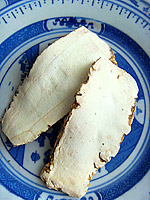 |
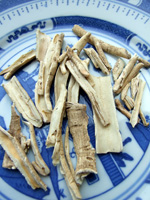 |
 |
| Dahurian angelica root |
Dictamnus root bark |
Peony root bark |
Below are general references to herbal selections for some itchy conditions:
Itchy conditions |
TCM treatment principles |
Sample herbs |
| Acute itchy rashes (red rash indicates heat; pale rash indicates cold) |
| Disperse wind to stop itching |
Chrysanthemum, ledebouriella root, schizonepeta herb, Siberian cocklibur fruit |
| Cold wind type add: |
Ephedra, cassia twig, Dahurian angelica root |
| Heat wind type add: |
Peony root-bark, great burdock fruit, pepper mint |
|
| |
|
|
| Intense itchiness with bright-red rashes, hot and prickly sensations |
| Clear heat to stop itching |
Unprocessed gypsum, anemarrhena rhizome, figwort root, baical skullcap root, golden thread rhizome, buffalo horn, Chinese gentian root, weeping forsythia capsule |
| Toxic heat type add: |
Gardenia fruit, wild chrysanthemum, honeysuckle flower |
| Heat-wind type add: |
Sweet wormwood herb, cicada slough, mulberry leaf |
|
| |
|
|
| Winter itchiness, or elderly and immune weakened individuals that appear dry and scaly skin |
| Boost internal lubrication to stop itching |
Unprocessed fleeceflower root, Chinese yam, flat-stem milkvetch seed, rehmannia root, lily bulb, gambir vine stem, longan aril, black sesame, white peony root, tuber fleeceflower stem, wolfberry root-bark |
| Menopause |
Mimosa tree bark, donkey-hide gelatin |
|
| |
|
|
| Localized itchiness that cause skin peeling, cracking, blisters, or softening in the lower legs, genitals or finger webs |
| Regulate body fluids to stop itching |
Agastache, fortune eupatorium herb, atractylodes rhizome, coix seed, belvedere fruit |
| Heat type add: |
Capillary wormwood herb, talc, dictamnus root bark |
| Cold type add: |
Betel nut, erythrina bark, sevenlobed yam rhizome |
| Herbs to arrest secretions and stop itching |
Smithsonite (calcined), black catechu, spiral shell powder, processed alum, gypsum (calcined), ophicalcite |
|
| |
|
|
| Drug side effects |
| Detoxify to stop itching |
Mung bean, unprocessed liquorice root, dyers woad leaf, dandelion, glabrous greenbrier rhizome, honeysuckle flower, Tokyo violet herb, arnebia root, isatis root |
|
| |
|
|
| Food allergies |
| Promote digestion to stop itching |
Dandelion, picrorhize root, medicated leaven, costus root, combined spicebush root, millet sprouts, barley sprouts, unprocessed Chinese rhubarb |
| Fishes or seafood |
Perilla leaf, dried tangerine peel |
| Meats |
Hawthorn fruit, chicken's gizzard-skin |
|
| |
|
|
| Alcohol allergic |
| Promote the alcohol expelling process to stop itching |
|
| Induce perspiration |
Cardamom, finger citron fruit, villous amomum fruit, kudzu flower, clove, nutmeg, hyacinth bean, lesser galangal rhizome, Tsaoko amomum fruit, mulberry fruit, hawthorn fruit |
| Promote urination |
Oriental water-plantain rhizome, polyporus, poria |
|
| |
|
|
| Persistent itching with darkened rashes and nodules on the skin |
| Resolve blood stasis to stop itching |
|
| Heat type |
Dried rehmannia root, cattail pollen, peony root-bark, red peony root, peach kernel, Indian madder root, turmeric root-tuber |
| Damp type |
European verbena, Taiwan sweetgum |
| Cold type |
Notoginseng, angelica root, frankincense, hirsute shiny bugleweed herb, Sichuan lovage rhizome, Chinese honeylocust spine, sappan wood |
|
| |
|
|
| Persistent itching with a creepy feeling and dryness; aggravated at night or triggered by seasonal changes |
| Rectify internal deficiencies |
|
| Yin deficient type |
Dendrobium, asparagus root, dwarf lily-turf tuber, fourleaf ladybell root, egg york, dried rehmannia root |
| Yang deficient type |
Cassia bark, psoralea, cornus fruit, epimedium, common curculigo rhizome |
| Qi deficient type |
Astragalus root, Chinese yam, largehead atractylodes rhizome, pilose asiabell root |
| Blood deficient type |
Processed rhemannia rhizome, donkey-hide gelatin, mulberry fruit, fleeceflower root |
|
| |
|
|
| Parasitic or fungal infections with skin itching, peeling, discharges and cracks |
| External remedies are mainly applied for symptom relief and to arrest further development |
Common cnidium fruit, realgar, shrubalthea bark, veratrum root, calomel, processed alum, sulfur, chaulmoogratree seed, aloe, centipede |
|
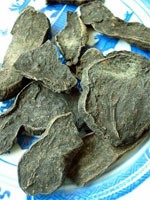 |
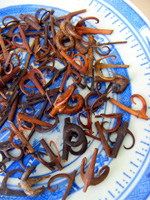 |
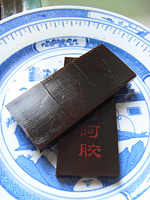 |
| Fleeceflower root |
Gambir vine stem |
Donkey-hide gelatin |
Generally, many physicians like to use plant parts like cortex, thorns or barbs as the main ingredients in the anti-itch prescriptions.
Sometimes, TCM physicians may select insects or animal products such as centipede, scorpion, silkworm, beehive, snack slough, earthworm and leech to treat stubborn itchy cases. It is said that these ingredients are very effective to detoxify, dig and unblock meridian collaterals, and resolve blood stasis which can play a significant role for itchy relief. It should be noted that these ingredients are used under strict monitoring and in limited does only.
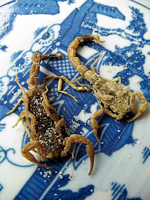 |
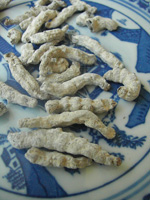 |
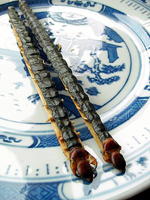 |
| Scorpion |
Silkworm |
Centipede |
|